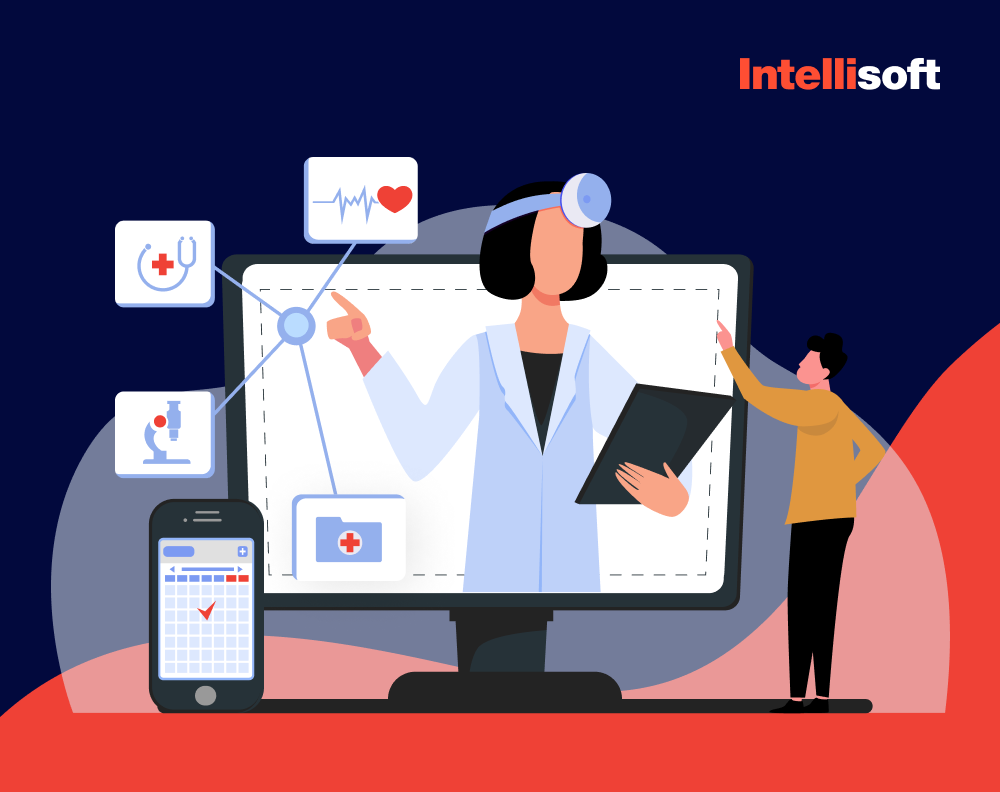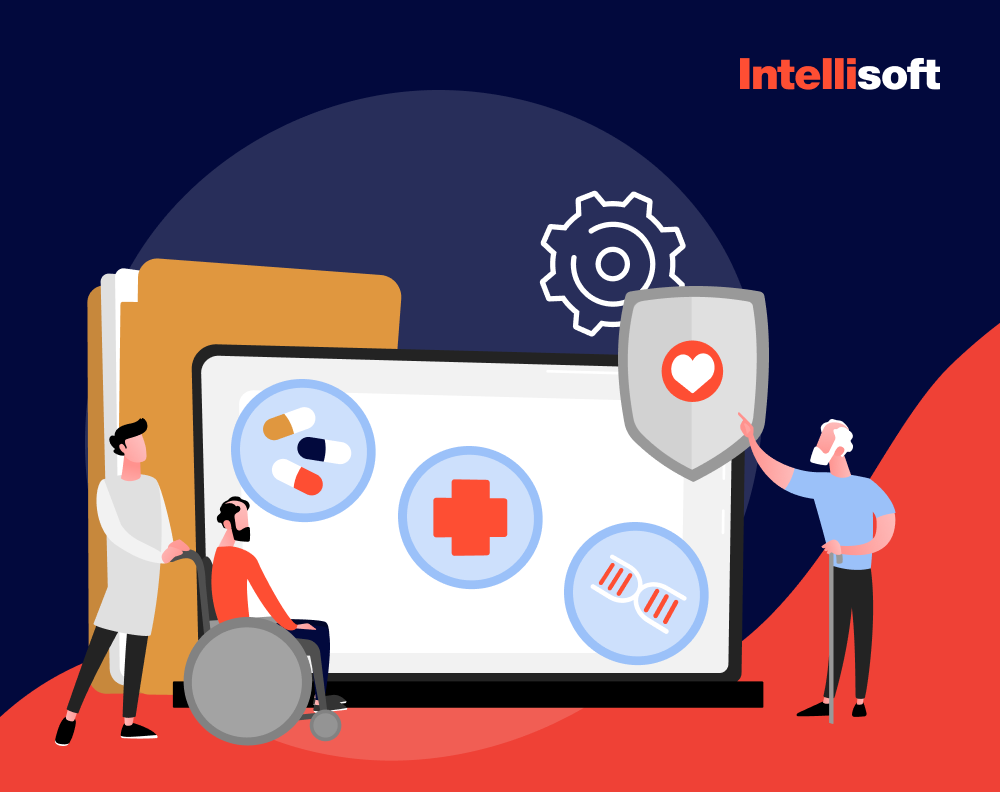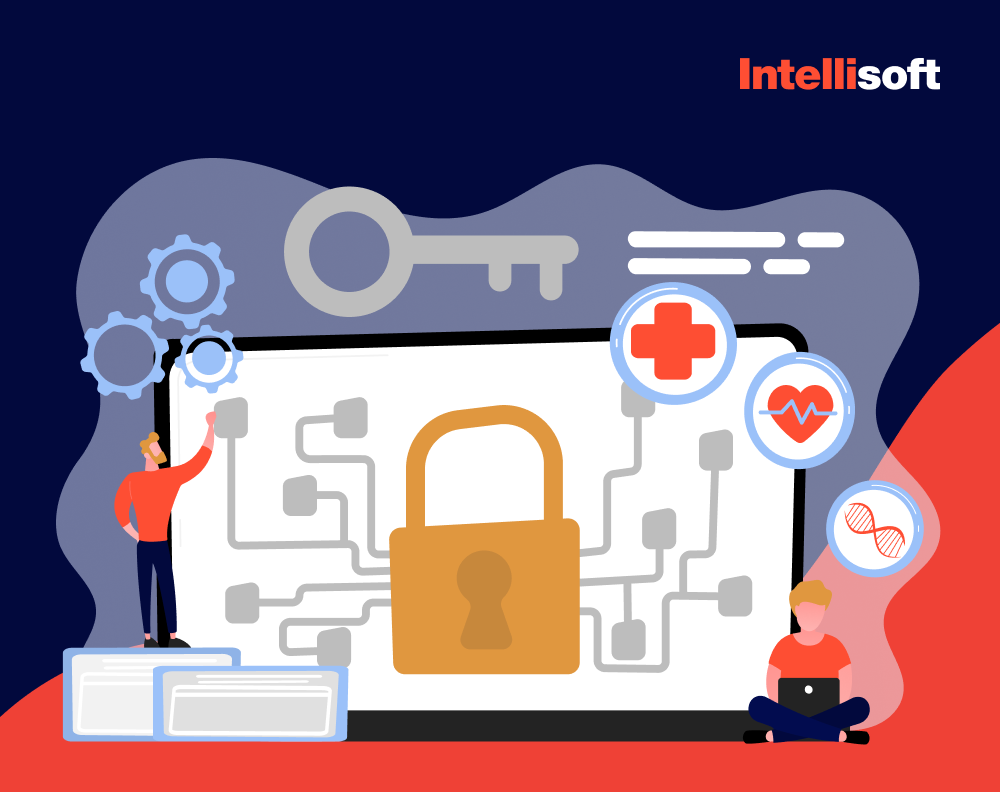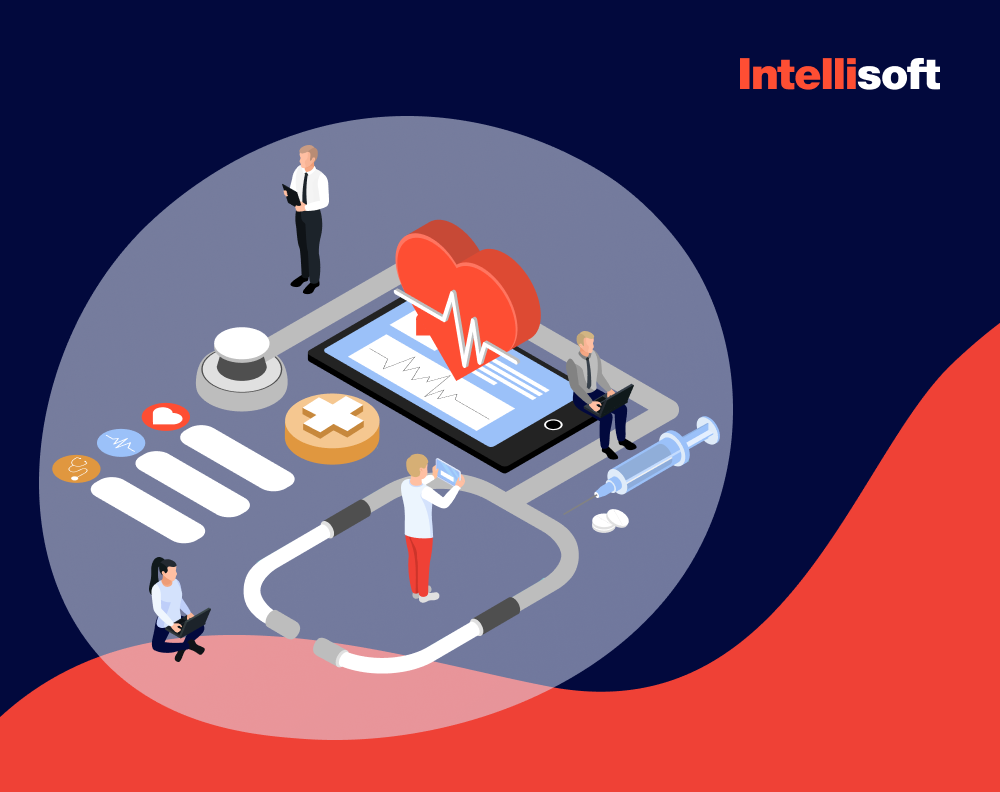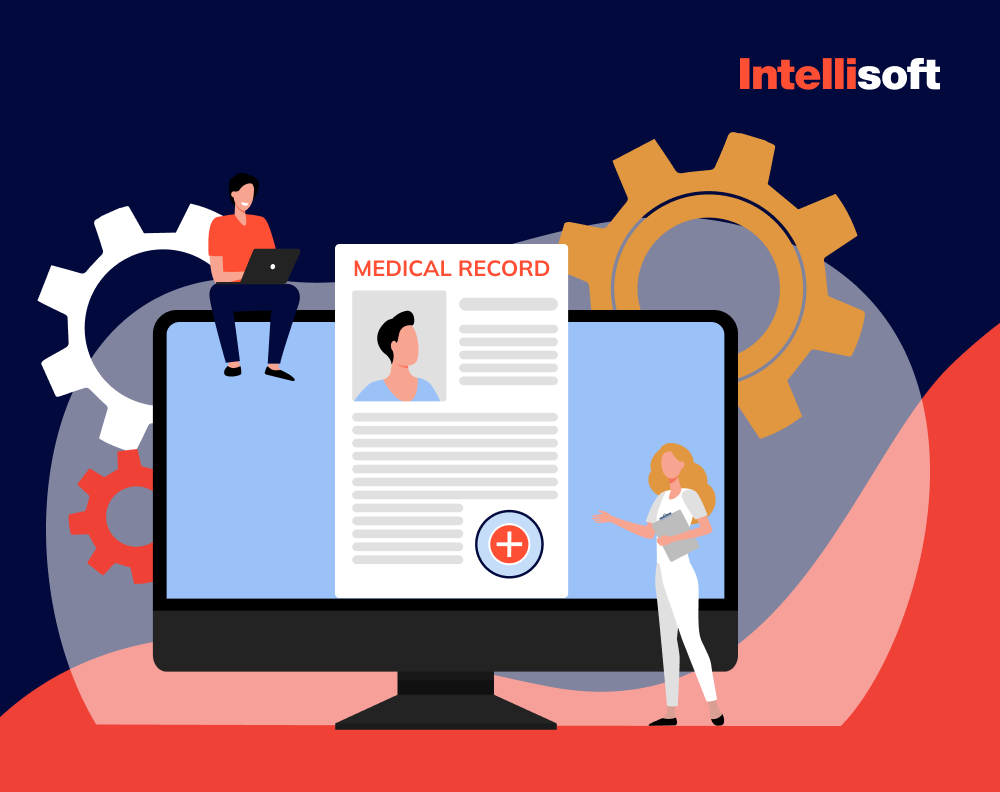Picture a world where extensive data supports every health-related decision. This goal is achievable with a healthcare data warehouse (DWH). This powerful digital hub stores and analyzes vast amounts of medical information. In today’s world, where going digital is essential, these DWHs are vital in transforming medical services.
At IntelliSoft, we’re aiming to be the driving force behind this shift. Our software development expertise and understanding of healthcare complexities place us at the forefront of this digital revolution. We know how to handle everything safely, from patient records and insurance details to test results and prescriptions, transforming raw data into actionable decisions and meaningful insights.
In this article we’ll uncover the untapped possibilities of healthcare data warehousing. Let’s find out how to navigate the information-rich landscape of modern medical aid and pave the way to a healthier future.
Table of Contents
What is Data Warehouse in Healthcare?
Envision the clinical data warehouse in healthcare as a central hub in the medical world, a key to unlocking vast volumes of vital information. This isn’t just about storing digital patient histories: It involves gathering, organizing, and preserving extensive records from varied sources, including patient details, insurance specifics, and financial data. It’s a transformation of this vast collection into something impactful and actionable.
So, what’s the fuss about? The market for healthcare data warehousing is soaring, projected to hit an impressive $7.7 billion by 2030. This isn’t a passing phase – it’s a fundamental shift in how medical assistance is delivered. Leading entities in the medical field are already harnessing the power of these information hubs, and the benefits are substantial.
Consider the massive volume of digital records generated by hospitals and medical projects. It’s overwhelming! The challenges of 2020 brought to light the urgent need to rectify inefficiencies, calling for an overhaul of existing systems. Add to this the influx of data from health-tracking devices and the increasing digital transformation in the medical world, with systems like electronic patient records becoming the norm.
Another critical issue is the frequent occurrence of incorrect diagnoses, often due to common symptoms such as fever or pain masking more severe conditions. These centralized information systems offer a beacon of hope, promising to elevate the predictive and functional capabilities of medical care.
How does data warehousing in healthcare differ from typical databases? They serve as a unified point where records from various medical IT systems converge. These hubs organize these records, simplifying analysis and integration with other technologies such as comprehensive data pools and machine learning.
So, what is data warehousing in healthcare? In summary, a clinical data warehouse in healthcare is more than a mere storage facility. It plays a pivotal role in contemporary medical decision-making, enhancing operational efficiency and shaping future medical strategies.
The Evolution of Medical Information Management Systems
Let’s take a short trip through the history of medical information management systems, a path that’s filled with technological leaps striving for improved patient outcomes and smoother operations.
The Early Days: Paper Trails and Manual Records
In the beginning, recording patient details was a manual affair. Hospitals and clinics were filled with physical files, resulting in a vast sea of paper. This straightforward method had its pitfalls: accessing past patient records was slow and error-prone. In urgent situations, delays in retrieving crucial patient details could have significant consequences.
The Digital Leap: Birth of Electronic Records
Then came the era of computers, sparking a transformative wave. Medical facilities started shifting to electronic records, marking a crucial step towards more efficient information management. This change reduced the need for physical storage and expedited the process of accessing and sharing patient details. Yet, these early digital systems were often disjointed, with different departments using incompatible platforms, creating isolated information islands.
Bridging Gaps: Integrated Systems
To tackle this fragmentation, integrated information systems stepped in. Their mission was to merge various patient details into a unified format. While a step ahead, these systems mainly focused on storage and retrieval, offering limited analysis and reporting features.
The Modern Era: Advanced Analytics and Predictive Models
The recent decade has brought about a substantial transformation, introducing advanced analytics and predictive modeling. These aren’t just vaults of records – they’re intelligent tools providing key insights. The incorporation of machine learning and artificial intelligence has empowered healthcare professionals to do more than store and access patient details. They can now decipher patterns, forecast trends, and make well-informed decisions.
The Future: Seamless Integration and Personalized Care
Peering into the future, we see a world where medical information management aims for even more seamless integration and individualized patient care. The goal is to craft systems that not only gather and handle patient details but also communicate with wearable healthcare devices, include genomic information, and offer real-time analytics for customized treatment plans. This dream of a fully integrated, information-driven medical system fuels ongoing advancements in this field.
The Impact on Patient Care and Operations
The benefits of these developments on patient care and hospital operations are immense. Quicker access to complete patient histories has led to more precise diagnoses and effective treatment strategies. Operational efficiencies have been achieved through streamlined information management, reducing administrative work and allowing medical staff to concentrate more on patient care.
The Challenge of Keeping Pace
Yet, this evolution brings its challenges. Staying up-to-date with rapid technological changes demands continual investments in both technology and training for medical and administrative personnel. Furthermore, with the surge in the volume of patient details, safeguarding their security and privacy is paramount.
The transformation of medical information management systems over the years is a story of significant milestones, each enhancing the quality of patient care and operational efficiency. This historical perspective sets the stage for appreciating the real-life impact and advantages of the latest innovation in this field: the adoption of modern information warehouses in medical settings.
How a DWH Addresses Urgent Problems of Healthcare Organizations
In today’s ever-changing medical aid scene, DWHs are more than tech tools – they’re essential problem solvers. Let’s explore how DWHs are uniquely equipped to address some of healthcare’s most pressing issues.
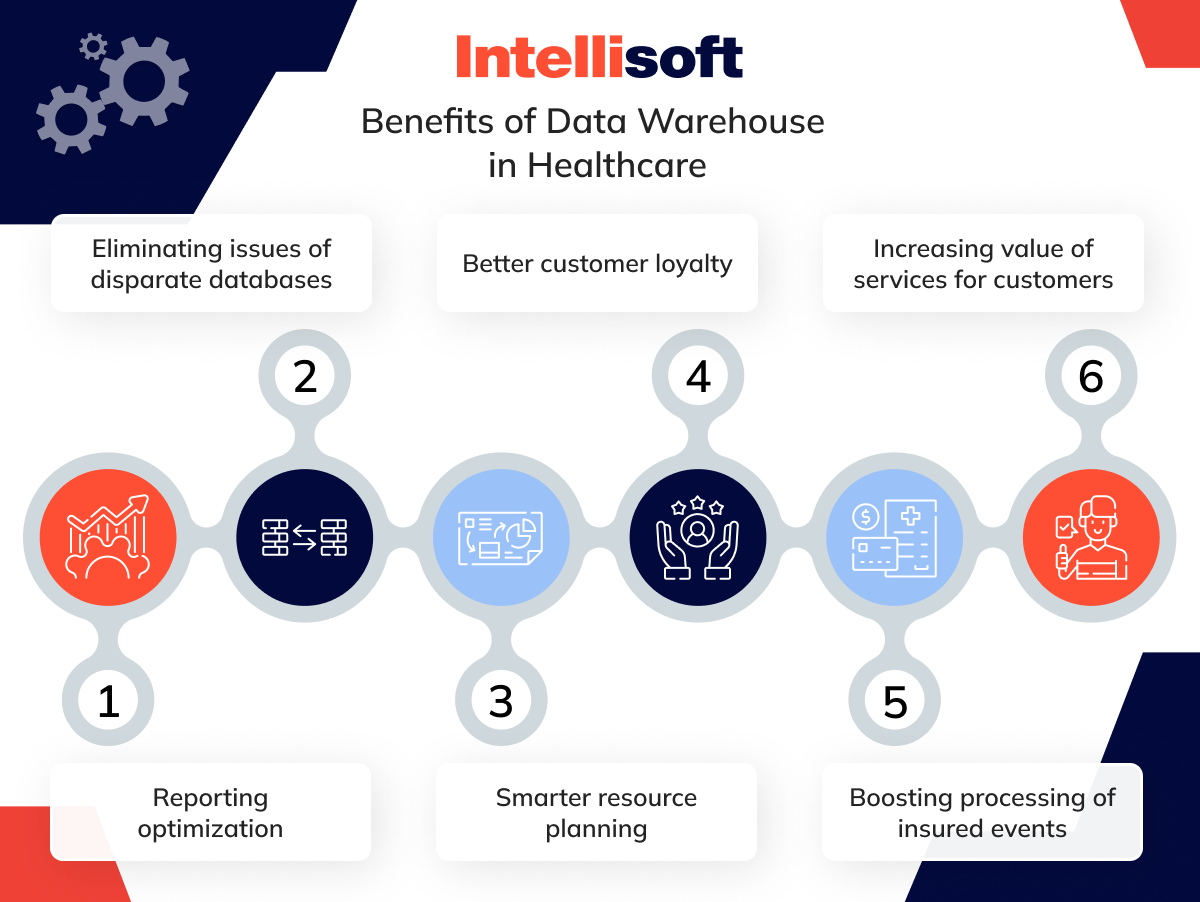
Streamlining Reports
Think of a DWH as a central hub for information. It simplifies the way healthcare professionals interact with data for reports and analysis. Imagine quickly browsing patient histories, analyzing medication sales trends, or evaluating medical service quality. This functionality is crucial for tasks like monitoring epidemics. DWHs are often used alongside information visualization tools, making complex reports easy to understand, even for those not versed in data analysis.
Solving Database Disparities
Traditional databases have drawbacks: they’re slow, hard to use and lack analytics tools. DWHs, on the other hand, offer user-friendly tools for efficient data processing and analysis. This technology benefits clinical diagnosis and helps develop patient retention and acquisition strategies.
Enhancing Insurance Processing
In the complex world of medical insurance, DWHs add clarity and speed. They help refine insurance policies, improve accuracy, and prevent fraud. This comprehensive patient information is crucial in managing insurance events effectively.
Optimizing Resources
Adopting a DWH is a smart strategy for resource planning in medical institutions. It promotes an integrated approach to managing resources. Many medical centers link their clinical data warehouses with inventory systems, CRM, and other software, achieving a well-rounded resource management plan.
Building Customer Loyalty
DWHs provide medical staff with a complete picture of a patient’s history, fostering trust and confidence and thus enhancing patient loyalty. They improve upon traditional customer service models by eliminating delays and inaccuracies in clinical diagnoses.
Improving Service Value
When combined with machine learning and AI, healthcare DWHs enable more accurate diagnostics. This approach improves the quality of services and leads to more effective treatments, reducing unnecessary medical expenses for patients.
As you can see, DWHs in healthcare are more than mere information storage – they provide vital tools that tackle everything from operational efficiency to enhancing patient satisfaction and the value of services.
Exploring the Capabilities of a Medical Information Management System
Picture a medical DWH as a versatile crystal, shedding light on various aspects of patient and hospital information in a clear and insightful manner. Below, we delve into the capabilities that make a medical DWH an essential tool in modern medical management.
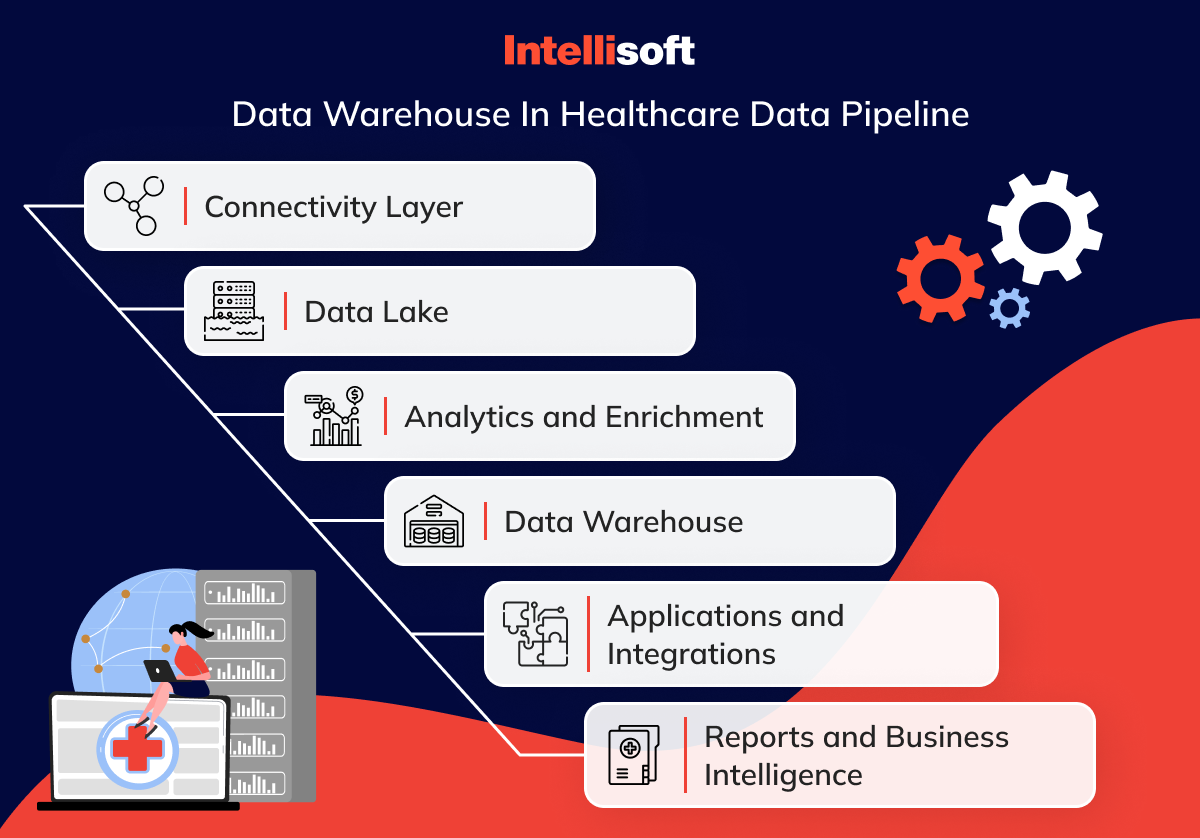
Central Information Collection Point
At its core, a medical DWH serves as a pivotal collection point for vital patient and hospital details. It consolidates diverse types of information, ranging from patient medical histories and administrative hospital data to results from diagnostic tests and inputs from personal health tracking devices. This convergence offers a unified and integrated view of all relevant medical details.
Boosting Clinical Decision Making
One of the key roles of a medical DWH is to enhance decision-making in patient care. It provides medical professionals with comprehensive access to a patient’s historical and current health details, laboratory results, and past treatments. This access facilitates precise, informed decisions in patient care, elevating the quality and timeliness of medical support.
Overseeing Community Health Trends
In overseeing community health, a medical DWH proves indispensable. It examines grouped patient details to identify health patterns, potential disease outbreaks, and general wellness levels across communities. This is crucial for proactive health strategy formulation and specific health initiative planning.
Upholding Regulatory Compliance
Ensuring compliance with medical industry standards, especially regarding patient privacy and information safeguarding, is a fundamental feature of a medical DWH. It ensures all handling of sensitive patient details is lawful, safeguarding patient confidentiality and building trust.
Comprehensive Medical Analysis
The medical DWH’s multidimensional framework allows for intricate analysis across various treatment methodologies and healthcare decisions. This deep, layered examination leads to richer insights into treatment efficacy and patient health outcomes.
Merging Multiple Information Streams
A defining characteristic of a medical DWH is its capacity to amalgamate details from disparate systems such as patient records, insurance claims, supply management, and expenditure records. This harmonization provides an all-encompassing perspective on medical operations, enhancing resource distribution, cost control, and overall operational efficacy.
The functionalities of healthcare data warehousing extend from unifying essential details, aiding in clinical judgments, overseeing community health, ensuring regulatory adherence, delivering in-depth analytical insights, to merging varied streams of information, establishing it as a vital instrument in contemporary medical management.
Related readings:
- Automation in the Industry of Healthcare: Main Benefits for Business
- Predictive Analytics in Healthcare: How To Implement In Your Organization
- Leveraging Data Analytics: A Guide to Revolutionizing the Pharmaceutical Industry
- Transforming Healthcare Communication: Integration of HL7 Interface Engine
- What Technologies Are Driving the Health Protection System?
Understanding Data Warehouse Architecture for Healthcare
Think of a healthcare DWH as a complex puzzle designed to handle the medical aid world’s vast and intricate information flow. Let’s unpack the data warehouse architecture for healthcare into its fundamental parts and roles.
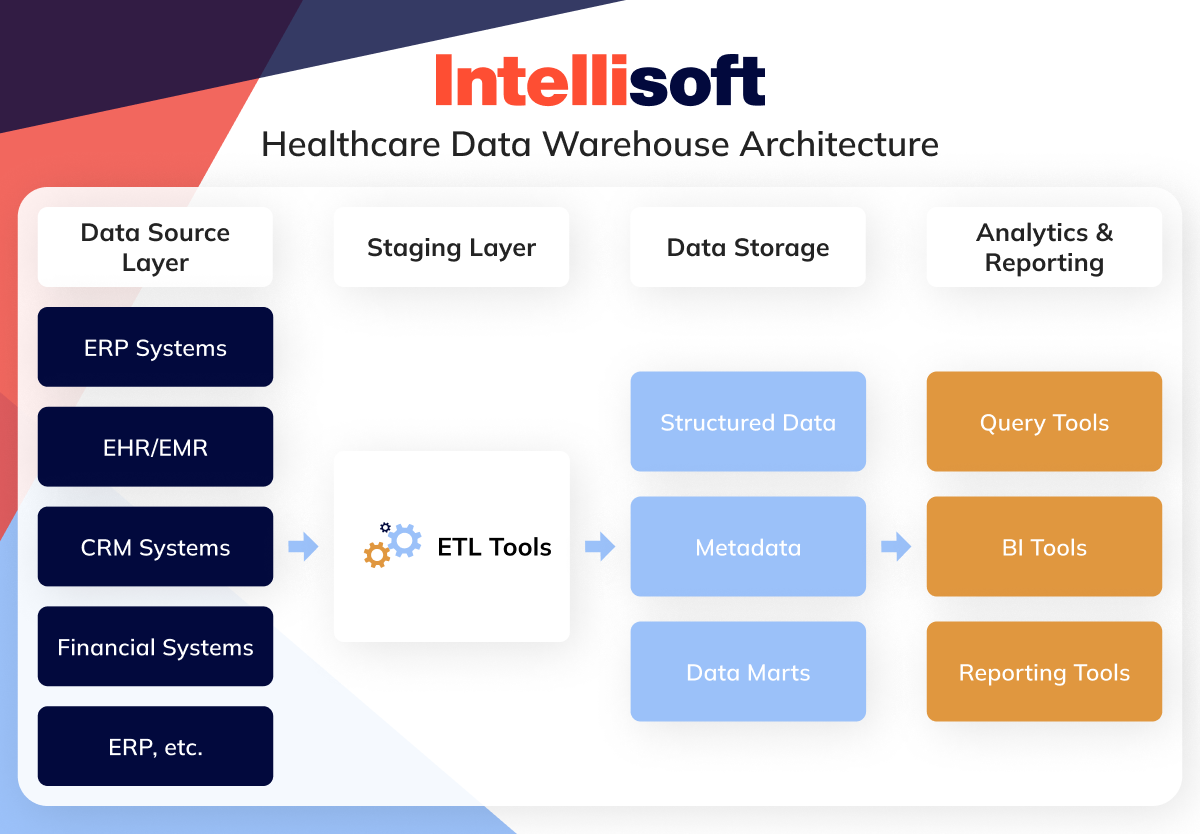
Data Source Layer
This layer is the foundation. It’s a mix of internal and external information sources essential for healthcare providers. Picture it as a collection point for various information – from ERP systems overseeing daily business tasks to EHR and EMR systems documenting patient interactions. Add in radiology reports, prescriptions, CRM systems for managing customer relationships, systems for handling claims, and even patient feedback. This data layer is the starting line where all this diverse information begins its transformation into valuable insights.
Staging Layer
Moving up, we find the Staging Layer. It’s a temporary spot where information from various sources is stored. Here, ETL (Extract, Transform, Load) tools work their magic. They clean the raw data, fix inconsistencies, and prepare it for deeper analysis. This step is crucial to ensuring the information is uniform and set for efficient storage.
Data Storage Layer
The Data Storage Layer is where all the information is kept after being processed. It’s like a big digital filing cabinet where data is neatly arranged, making it easy to find what you need for reports and analysis. Within this layer, there are smaller sections called data marts. Each of these is dedicated to a specific part of the organization, like HR or finance, allowing for more detailed analysis in each specific area.
Analytics and Reporting Layer
Sitting at the top is the Analytics and Reporting Layer. This is where all the stored data gets transformed into useful information. Using Business Intelligence tools and different querying applications, this layer digs into the data to pull out necessary insights for healthcare providers. It’s all about turning numbers and facts into understandable reports, visuals, and graphs, helping those in healthcare make smart, informed decisions.
Healthcare DWH architecture is a well-structured, multi-tiered system. Each layer builds upon the previous one, ensuring medical aid providers have accurate, comprehensive, and actionable information.
Choosing the Right Data Warehouse Deployment for Healthcare
Picking the right healthcare data warehouse design is a big deal. It affects how smoothly things run and keeps your information safe. Let’s look at the three main paths: on-premise, cloud hosting, and a hybrid approach, each with its unique benefits and things to think about.
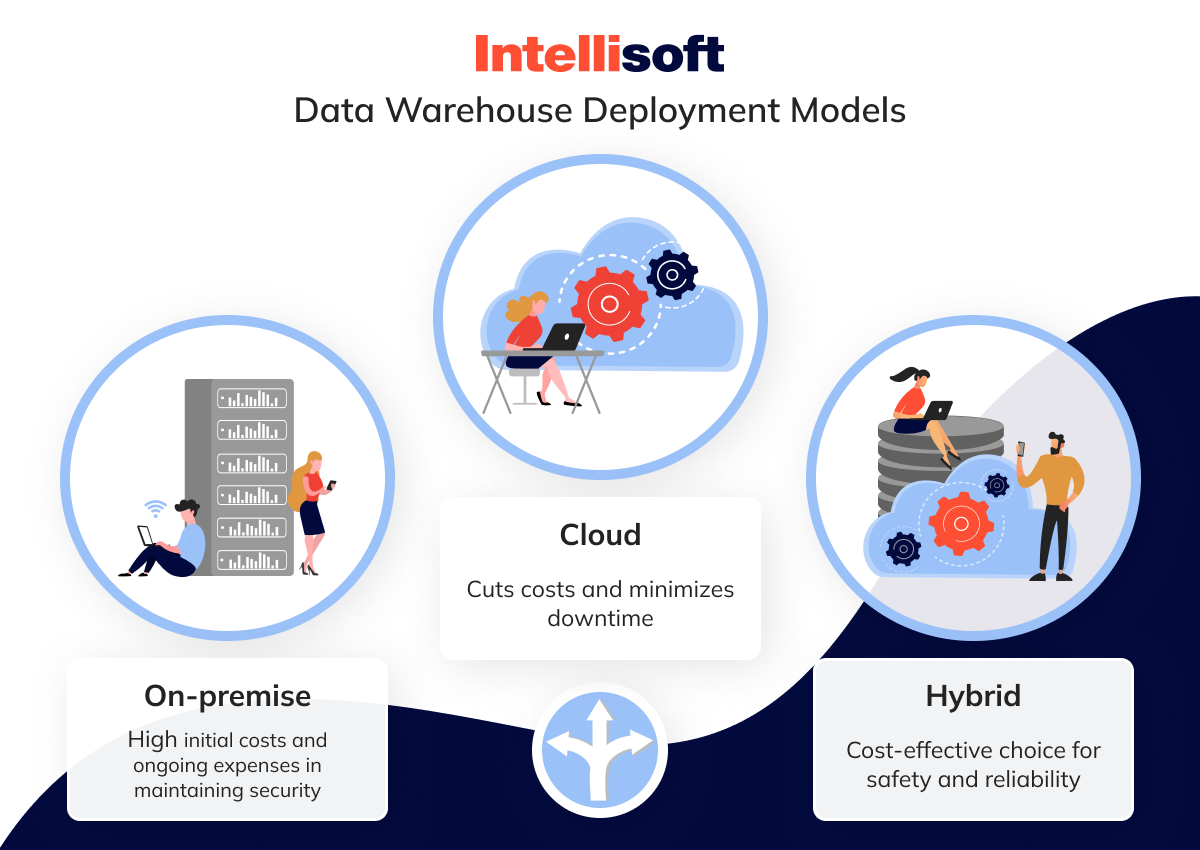
On-premise Deployment
Going for on-premise healthcare data warehouse design is like having your own secure vault. It’s great for big companies needing lots of computing power and their own IT crew. This traditional route means you can have tight security and meet all the compliance rules, lowering the risk of data breaches.
It’s perfect for public healthcare bodies with strict privacy rules or if you have trouble mixing current software with cloud stuff. It keeps patient information under your roof, following strict privacy laws. But remember, this choice can be pricey, with high startup costs and ongoing expenses in maintaining top-notch security and reliable systems. It’s a big commitment.
Cloud Hosting
As your healthcare group grows, you’ll want a more flexible and secure healthcare data warehouse model. That’s where cloud hosting shines. It lets you handle your DWH on a cloud server, leaving the nitty-gritty of backups, updates, and system stability to someone else. This approach means you can focus more on providing medical services.
Cloud servers are dependable and easy to access from anywhere. They don’t break down much, and if they do, it’s the cloud provider’s job to fix it, not yours. This choice cuts costs and minimizes downtime. It’s especially wallet-friendly for small and medium-sized places, offering advanced security without a considerable investment.
Hybrid Model
The hybrid healthcare data warehouse model combines the best parts of both on-premise and cloud hosting. It’s perfect for growing organizations using cloud innovations for new digital projects while keeping established processes on local servers for extra security.
Using cloud services for backup is a smart choice here. It means you don’t have to spend on extra servers for backup, making it cost-effective to keep your systems safe and running smoothly.
Picking the right DWH setup for your organization means considering your size, future plans, security needs, and budget. Whether you choose full control with on-premise, the flexibility of cloud hosting, or the balanced hybrid healthcare data warehouse model, your choice will shape your data management strategy for the long haul.
How to Implement a Data Warehouse for Healthcare Organizations
Deploying a healthcare DWH is a journey through a landscape of complex information, sophisticated technology, and strategic planning. Here’s a comprehensive roadmap to navigate this terrain and help ensure your organization’s transition to data warehousing is smooth and successful.
Step 1. Strategic Planning
The genesis of a healthcare DWH implementation is strategic planning. This initial phase is a crucible of critical thinking and decision-making, where stakeholders come together to lay the groundwork. Key activities include:
- Understanding your needs
- Spotting data hiccups
- IT systems check
- Setting goals and metrics
- Budgeting
- Blueprinting
Engage with stakeholders to understand their data needs and expectations from the DWH. Pinpoint current inefficiencies in data management that the DWH will address. Evaluate existing IT systems to determine how they will integrate with the new DWH. Outline clear goals and measurable indicators of success for the DWH. Allocate financial resources based on the scale and complexity of the DWH. Draft a detailed plan for the DWH that resonates with stakeholder requirements.
Step 2. Architectural Design
In the architectural design stage, your chosen team of developers will begin to blueprint the DWH’s framework. It’s a meticulous process that involves:
- Data integration plan
- Data modeling
- OLAP cubes
- Data sources
- Data transformation plans
- Final design steps
- Accuracy checks
Decide how you will integrate and manage information from various sources. Develop a conceptual, logical, or physical data model that suits your needs. Formulate OLAP (Online Analytical Processing) cubes for multidimensional data analysis. Identify and establish connections to all relevant information sources. Plan for data transformation using ETL (Extract, Transform, Load) or ELT (Extract, Load, Transform) processes. Finalize the design of the data models and any necessary integrations. Establish protocols for tracking, duration, and validating information accuracy and integrity.
Step 3. Data Warehouse Development
With plans and designs in place, the development stage sees the actual construction of the DWH infrastructure. This phase involves:
- Setting up the framework
- Coding
- Software and apps installation
- Step-by-step rollout
Assemble the required hardware and software framework. Execute the coding sequences that will run your DWH. Install the backbone software of your DWH and any applications that end-users will interact with. Implement a schedule that allows for phased completion and review of different DWH components.
Step 4. Product Testing and Deployment
Now, it’s time to put the schema and data models into action on your chosen storage layer. Deployment considerations include:
- On-site setup
- Cloud options
- Hybrid configuration
If you’re hosting on-site, prepare for hands-on debugging and problem-solving with a skilled developer team. Options such as Databricks and Snowflake can simplify cloud-based deployment. Rigorously test all aspects of the DWH to ensure they meet functional and performance standards.
Step 5. Continued Post-Migration Testing and Maintenance
The DWH is live, but the journey doesn’t end there. Ongoing maintenance ensures the system remains responsive and relevant:
- Regular updates
- Continuity testing
- Maintenance
Adjust and update the DWH in response to new medical metrics, user feedback, or changes in healthcare data standards. Regularly test the system to ensure it can handle data evolution and any new integration requirements. Keep the DWH in peak condition with routine maintenance, addressing any issues promptly.
Implementing a DWH in healthcare is a major but rewarding task. It improves data management and decision-making in this data-centric field. With thorough planning, building, testing, and maintenance, your DWH will be a key part of your organization’s tech growth.
What is the Cost of Implementing a Healthcare Data Warehouse?
Let’s talk about money, which is a must when planning a healthcare DWH. The cost can vary widely, from $75,000 to over $250,000. Why such a big range? It boils down to a few key factors.
First up, size matters. A small clinic versus a sprawling healthcare network? Costs differ. Smaller setups need less, while big networks demand more dollars. Then there’s data integration. Consider all the information sources – patient records, billing, wearable tech. The more you have, the pricier it gets to blend them into your DWH smoothly.
Customization isn’t just a fancy word – it’s a real cost. Tailoring a DWH to fit your unique needs can bump up the bill. Sure, standard solutions are cheaper, but they might not fit your needs perfectly. In the medical aid industry, one size does not fit all. Security is non-negotiable. We’re talking about sensitive information here. Stronger security features like encryption and access controls mean higher costs.
Lastly, the analytical power of your DWH can be a game-changer. Want advanced analytics and real-time processing? That’s going to cost extra for the high-end tech needed.
So, why such a cost difference? It’s about value for money. In healthcare, skimping on costs now can lead to bigger expenses later. It’s crucial to consider your current needs and growth plan and invest wisely. You’re not just buying a product but investing in a data-smart future.
Essential Factors for Data Warehouse Success in Healthcare
Launching data warehousing in healthcare is no small feat. It requires a well-thought-out strategy, covering several vital areas to ensure it meets industry standards and boosts organizational efficiency. Let’s dive into the must-have items on your checklist.
It all begins with a clear vision. Strong leadership commitment is key to aligning the DWH project with the organization’s larger goals. It’s about improving patient care and streamlining operations. At the heart of your DWH is data governance. A solid framework here ensures information integrity, privacy, and security, keeping in line with healthcare regulations. Trust and legality in your information are critical.
Remember, quality data is crucial. Accuracy, completeness, and consistency are vital for dependable analysis and decision-making. Rigorous processes are needed to maintain data integrity from collection to analysis. Medical information is constantly evolving. Your data warehouse must be flexible, handle current data, and grow with future demands. It should integrate information from various sources, including EHRs, EMRs, and external databases.
Responsible handling of sensitive information is essential. Secure access controls and role-based permissions are necessary, allowing efficient data retrieval without compromising patient confidentiality or security.
The backbone of your DWH is its technical setup. From data collection and storage to analysis, the technology you choose is crucial. Cloud-based solutions offer flexibility, while on-premise options might offer more control. Your decision will hinge on factors like regulations and operational needs.
The implementation of a healthcare DWH is a tricky dance of precision and foresight, requiring attention to detail and a deep understanding of the healthcare environment. It is a commitment to the future where information transforms every aspect of medical aid delivery.
Wrapping Up: The Future of Healthcare with Data Warehouses
As we wrap up our discussion on data warehousing in healthcare, it’s clear that they stand as a symbol of progress. They promise enhanced patient care, streamlined operations, and smarter decision-making. The path to a successful healthcare enterprise data warehouse is intricate, blending strategic savvy, technical know-how, and adherence to compliance. It’s about crafting a knowledge hub that meets today’s standards and is ready for tomorrow’s innovations.
Looking back at the crucial role of healthcare DWH implementation, the importance of expert guidance becomes apparent. This is where IntelliSoft makes its mark. With our deep-rooted experience in software development and a sharp eye on technological trends, IntelliSoft is the ideal partner for healthcare organizations starting this journey.
Partnering with IntelliSoft for your data warehouse project is more than just a technical collaboration – it’s a step towards leading your organization into the forefront of healthcare innovation. Let’s work together to transform your information into a powerful tool for better medical aid outcomes. Reach out to IntelliSoft and start shaping a data-empowered future for your organization.


